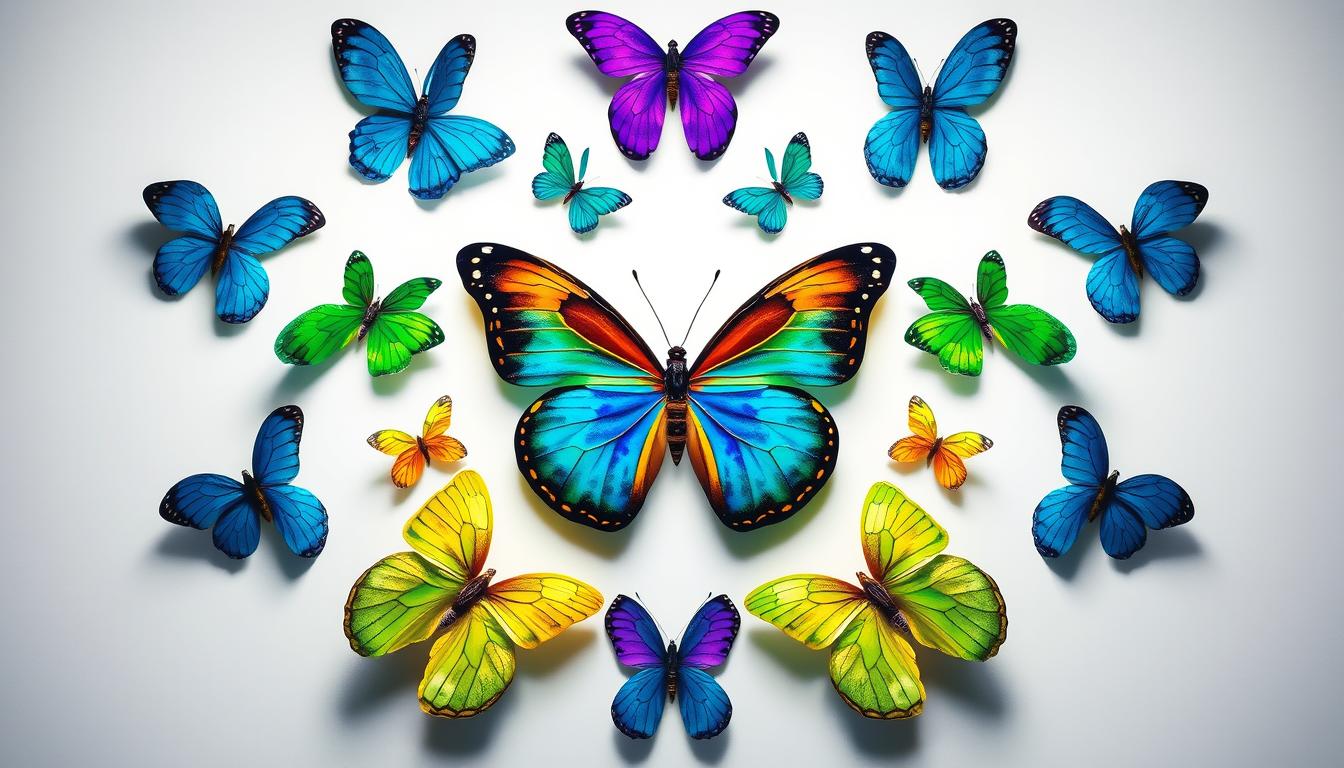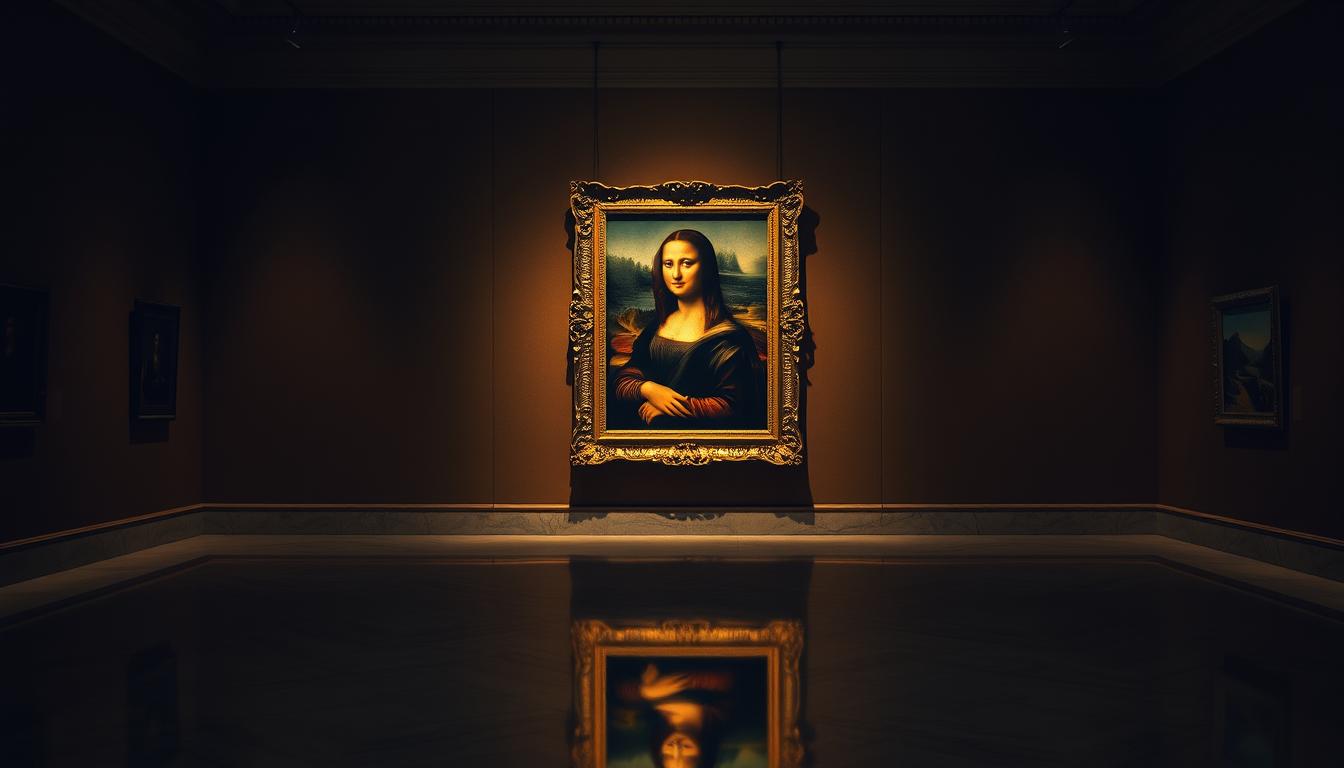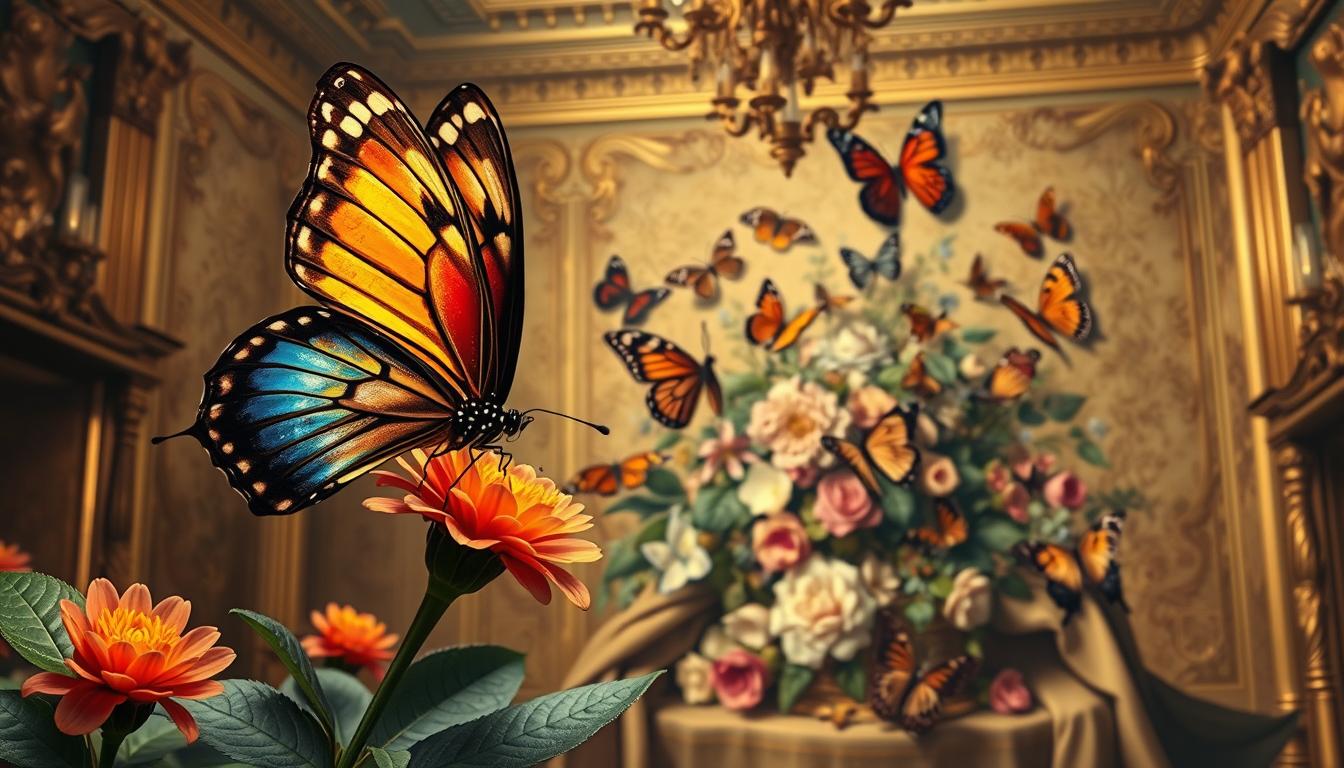Damien Hirst is the name most people call when asked this exact question. His use of butterflies became a signature image in contemporary art and shaped how many remember his work.
Hirst first focused on insects in the late 1980s. Studio experiments with flies led to room-scale projects where live insects hatched, flew, and died. That contrast of beauty and decay made the motif unforgettable.
His pieces range from prints and paintings to stained-glass-like arrangements made with real wings. Works like The Souls and I Love You show how this symbol links ideas of growth, change, and mortality.

This intro previews how those works, exhibitions, and debates shaped Hirst’s public image and left a lasting mark on contemporary art.
Key Takeaways
- Damien Hirst is the artist best known for the butterfly motif.
- The motif began in late-1980s studio experiments and grew into room-scale projects.
- His work uses real insects across paintings, prints, and installations.
- The image ties to themes of life, death, and transformation.
- Hirst’s butterfly pieces sparked debates about ethics, spectacle, and meaning.
The short answer: Damien Hirst is the artist best known for butterfly art
When people recall polished insect prints and heart-backed paintings, Damien Hirst often comes to mind first. This is the concise takeaway: Damien Hirst is, without doubt, the artist most closely associated with this motif in museums, fairs, and the market.
Hirst’s imagery repeats across major series, notably The Souls and the Love works. Those titles riff on Beatles lines—All You Need Is Love; I Love You—and appear as playful yet sharp labels in exhibition lists and auction catalogues.
His prints and paintings read as hyperreal images. Butterflies often sit like a vivid, accidental brush stroke against bright hearts. That contrast—seductive surface and a sting of mortality—explains much of Hirst’s lasting public interest.
- Hirst’s market profile ties his name to these works across collections and shows.
- “Hirst love” and entitled love labels recur, signalling the approach in titles.
- The image is both immediate and conceptually layered, making it easy to spot in galleries.
How Damien Hirst’s butterfly motif took flight
An accidental moment in the studio — insects stuck on fresh ground — sparked a long-term motif. That late-1980s incident, while he prepared A Thousand Years (1990), redirected his practice toward living organisms and decay.
Late-1980s origins: from flies on canvases to a lifelong obsession
Flies adhered to primed canvases during painting sessions. Hirst turned that accident into a deliberate method. He began to mix natural processes with painted surfaces to stage life and death.
In and Out of Love (1991): a room of live butterflies and the cycle of life and death
In 1991 Hirst presented an installation often titled In and Out of Love. A humid room held pupae glued to canvases, sugar for feeding, and butterflies as they hatched, flew, and died.
This live setup collapsed nature and artwork into one changing spectacle. The use of live animals — alongside earlier displays of dead animals in tanks — sparked sharp ethical debates. That controversy helped define his early reception and set the tone for later series.
Inside Hirst’s Love series of butterfly prints and paintings
The Love series pairs sugary titles with a sharp reminder that beauty changes and ends. These works borrow Beatles lines like All You Need Is Love and twist that optimism by adding an awareness of mortality.
Beatles-inspired titles and optimistic sentiments fused with mortality
Hirst used cheerful, entitled love phrases to set a tone. The titles feel upbeat while the pictured life span quietly intrudes. That contrast makes the message hit harder.
Aesthetic choices: hyperreal butterflies, bold hearts, and the “accident of paint” look
The screen prints mimic a happenstance: an accidental smear with insects stuck on it. Yet each print shows unique, jewel-like butterflies against high-impact colour hearts. Collectors prize that mix of spontaneity and strict control.
Connections to The Four Elements paintings and the move to painted butterflies
These prints link back to The Four Elements (2005), where painted butterflies first appeared. Across painting and print, Hirst keeps an image that looks both photographic and hyperreal. The repeated motif becomes a device to think about time, repetition, and fragile life.
- What to look for: crisp edges, saturated colour, and the uncanny feel of life rendered as an emblem.
- Why it matters: the series fuses pop immediacy with conceptual rigour inside contemporary art.
For a focused overview of the Love chronology and edition details, see this short guide on Hirst’s Love works.
What butterflies mean in Hirst’s world: life, death, religion, and universal triggers
The butterfly motif acts like a visual shorthand in Hirst’s practice, carrying a dense mix of feeling and idea. It signals simple pleasure and also a swift reminder that life ends.
Growth, change, and the romance of death in contemporary art
Wings in his prints and rooms stand for growth and sudden change. They also point to the romance of death: elegant, brief, and hard to ignore.
From Psyche to resurrection: classical and Christian symbolism in the motif
Hirst borrows old stories. The Greeks used the image for Psyche, a soul figure. Christians read those same forms as rebirth and resurrection, folding religion into modern questions about existence.
“Everyone loves butterflies”: Hirst’s pursuit of universal triggers
He calls such images universal triggers, alongside fears like glass or sharks, saying that everyone frightened by some things will often also respond to a small, pretty creature.
- Surface vs reality: the idealized image comforts, while live cycles confront viewers with true life death facts.
- Why it lasts: this compact symbol links prints, paintings, and installations into clear themes that invite both delight and unease.
Who is the artist well known for butterfly art? Exploring Hirst’s standout butterfly works
A short survey of standout titles shows how damien hirst shaped a signature visual language around insects and colour. This section highlights the main works to help you recognise his approach at a glance.
From The Souls and I Love You to stained-glass-inspired arrangements
The Souls series uses hyperreal, brightly coloured butterflies arranged in tight grids. Each panel feels jewel-like, where every insect reads as an individual part of a formal whole.
I Love You pairs bold hearts with crisp edges and photographic-looking butterflies. These prints and paintings make colour and composition feel immediate and iconic.
- Doorway To The Kingdom of Heaven (2007) evokes stained glass with real wings set into painted panels.
- Hirst balances uniqueness—no two wings match—with a serial method that gives cohesion across a series.
- Collectors often cite luminous colour, exacting detail, and the tension between fragility and permanence.
This selection shows how a few key works and consistent motifs let a single body of artwork carry a wide public meaning. Look for intense hue, sharp edges, and formal order when you want to spot his most familiar pieces.
From medicine cabinets to diamond skulls: how butterflies fit Hirst’s bigger themes
Across his career, damien hirst set clinical order beside theatrical excess to ask what we trust when life ends. Medicine cabinets and Pharmacy staged remedies like relics, arguing that science often takes on the role of religion in modern life.
Science as the new religion: Medicine Cabinets and Pharmacy
Medicine cabinets (1988) and Pharmacy (1992) use shelves, labels, and sealed bottles to mimic sacred display.
These cabinets frame medicine as a system of belief, mixing clinical exactness with ritual order.
For The Love Of God: diamonds, skulls, and confronting mortality
For The Love Of God (2007) — a platinum, diamond‑encrusted human skull — pushes that logic to excess.
It treats wealth and sparkle as an attempt to deny death, while Trinity and anatomical works add a scientific solemnity.
- How butterflies connect: both pretty and fragile, they sit within Hirst’s ecosystem alongside cabinets and specimens.
- Visual language: shelves, labels, and specimens create a sense of control that sharpens the question of belief.
- Final gesture: the diamond skull makes Hirst’s interest in mortality public, almost devotional.

For more context on how these displays landed in major museums, see a notable Tate Modern debate about spectacle and value.
Exhibitions and installations that shaped Hirst’s butterfly legacy
Room installations remade galleries into controlled ecosystems where viewers could watch nature run its course. These shows turned exhibition space into a staged laboratory and made visitors part of the event.
In and Out of Love (1991) became a flashpoint: pupae glued to canvases hatched, butterflies fed and flew, and some died in view. That setup raised ethical debate and cemented Hirst’s public profile.
Room-scale encounters: breeding, flight, and the ethical debate
Curators managed humidity, food stations, and pupae placement so the installation functioned. Visitors moved through a space that felt part chapel, part lab — a nod to stained glass panels like Doorway To The Kingdom of Heaven (2007).
"These works forced a choice: admire beauty or face how life ends."
- Exhibitions used scale and spectacle to link beauty, death, and belief.
- Practical care for animals shaped visitor flow and display design.
- Media attention amplified debates from YBA-era controversies to global audiences.
| Feature | Purpose | Impact |
|---|---|---|
| Humidity control | Support hatching and flight | Made galleries feel like labs |
| Pupae panels | Stage life cycles | Prompted ethical critique |
| Stained-glass panels | Reference religion and glass | Framed motif as sacred and secular |
Result: repeated exhibitions built a legacy where a single motif links spectacle, science, and belief across major shows.
Why Hirst’s butterflies mattered to the UK art scene
A mix of spectacle and provocation made his winged pieces impossible to ignore in Britain. As a leading Young British Artist, damien hirst tied shock to conversation and drew newcomers to gallery doors.
From vitrines of preserved animals to the diamond-encrusted skull, his works forced public debate. Those debates set the stage so prints and painted wings read as both seductive and subversive.

From YBA controversy to global recognition
In the UK, exhibitions that shocked critics also made contemporary art a topic in newspapers and schools. Hirst’s series landed in conversations about value, ethics, and taste.
- Context: YBA energy turned spectacle into a public grammar.
- Debate: materials — animals in tanks, a diamond skull — widened interest and outrage.
- Reach: gallery shows, reproductions, and auctions moved those visual ideas around the world.
| Feature | Effect | Legacy |
|---|---|---|
| Controversial materials | Media attention | Broadened audience for contemporary art |
| Accessible motifs | Public recognition | Works became cultural touchstones |
| Major exhibitions | Market and museum interest | Durable international profile |
Result: collectors, institutions, and the public learned to read Hirst’s visual language. That clarity—paired with controversy—made butterflies an emblem for his larger themes of mortality, belief, and beauty.
For more background, see a concise Damien Hirst profile.
Conclusion
The butterfly motif acts as a small, potent signal that links Damien Hirst’s bright prints, room installations, and stained-glass panels to a steady question about life and death.
Across the Love and Souls series, In and Out of Love, and Doorway To The Kingdom of Heaven, Hirst makes colour and surface feel immediate while asking deeper things about religion, science, and belief. Medicine cabinets, diamonds, skulls, and displays with dead animals sit in the same inquiry. If you want tips on spotting key paintings, canvases, or exhibition entries, or to learn more about entitled love and hirst love, email us at the address below. For direct follow up, email again and we’ll point you to shows, reads, and works that deepen this story.
Enhance Your Space with Unique Modern Masterpieces
Are you inspired by the innovative mediums and conceptual depth highlighted in our exploration of contemporary art? You’re not alone! Today’s art enthusiasts are seeking cultural relevance and emotional connections in their artwork. However, finding pieces that resonate with modern themes and fit your unique style can be a challenge. That’s where we come in!
At Rossetti Art, we specialize in canvas prints, original paintings, and modern sculptures that celebrate the spirit of now. Each piece created by Chiara Rossetti brings a personal touch that connects deeply with current social narratives—just like the modern masterpieces discussed in the article. Don’t miss out on the chance to elevate your home decor with breathtaking artwork that speaks to your values and aesthetic. Explore our collection today and find your perfect piece! Act now, and transform your space into a gallery of inspiration!
FAQ

Who is the artist well known for butterfly art?
Damien Hirst is the British contemporary creator most associated with butterfly motifs, using real and painted specimens across paintings, installations, and prints.
The short answer: Damien Hirst is the artist best known for butterfly art?
Yes. Hirst rose to prominence in the late 1980s and early 1990s and made butterflies a recurring visual theme that links beauty, life, and mortality.
How did Damien Hirst’s butterfly motif take flight?
The motif grew from early experiments with organic matter and formaldehyde to room-scale installations and studio paintings. Hirst moved from using flies and preserved animals to breeding live butterflies and arranging dead specimens into vivid compositions.
What happened in the late-1980s that led to a lifelong butterfly obsession?
Hirst began exploring life-and-death themes then, testing shock value and beauty together. Butterflies offered both delicate color and symbolic resonance, so they became a repeated subject across media.
What was In and Out of Love (1991)?
In and Out of Love was a room filled with live butterflies. The installation highlighted cycles of birth, flight, and death, raising praise and ethical questions about working with living creatures.
What defines Hirst’s Love series of butterfly prints and paintings?
The series pairs Beatles-inspired phrases and optimistic slogans with formal concerns about mortality. Pieces display hyperreal butterflies, bold hearts, and paint textures that suggest chance and control.
How do Beatles-inspired titles play into the work?
Titles like those echo popular culture to soften confronting themes. They create an accessible entry point while the imagery probes life, loss, and sentimentality.
How did Hirst move from The Four Elements paintings to painted butterflies?
The transition reflects a shift from abstraction toward representational imagery that still preserves an emphasis on color fields and surface effects, blending scientific curiosity with decorative beauty.
What do butterflies mean in Hirst’s practice?
They operate as symbols of growth, transformation, and the romance of death. Hirst layers classical and Christian references—from Psyche myths to resurrection imagery—while seeking universal emotional triggers.
How does Hirst use religion and science together?
He treats science as a modern faith by displaying specimens in cabinets and vitrines, while works like For the Love of God use jewels and skulls to confront spiritual and material approaches to mortality.
Which standout butterfly works should viewers know?
Key examples include The Souls, I Love You compositions, and stained-glass-like arrangements that combine symmetry, vivid color, and the tension between life and preservation.
How do butterflies fit into Hirst’s broader themes like Medicine Cabinets and diamond skulls?
Butterflies complement Hirst’s focus on death, value, and scientific display. Medicine Cabinets emphasize medicalization and order, while diamond-studded skulls dramatize value, loss, and spectacle.
What exhibitions shaped Hirst’s butterfly legacy?
Major shows featuring room-scale butterfly installations and gallery displays of prints helped cement his reputation, provoking debates about ethics, aesthetics, and spectacle in contemporary art.
Why did Hirst’s butterfly work matter to the UK art scene?
As a leading Young British Artist, Hirst challenged conventions and drew global attention to Britain’s contemporary art through provocative use of animals, vivid visuals, and media-ready themes.







Leave a comment
This site is protected by hCaptcha and the hCaptcha Privacy Policy and Terms of Service apply.